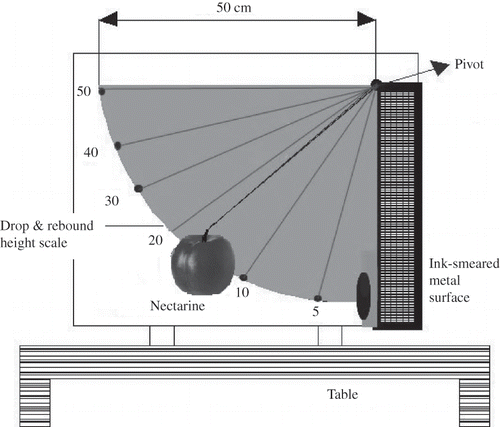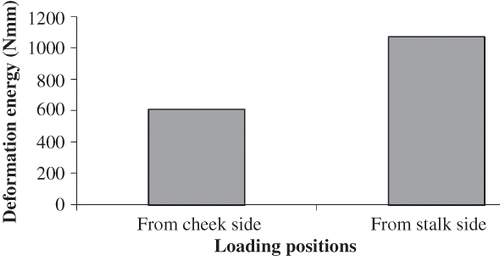Abstract
This research was conducted to evaluate some mechanical properties and bruise susceptibility of nectarine (Prunus persica variety). Compression and impact tests were conducted to determine the mechanical properties and the bruise susceptibility depends on the direct mechanical damaging of nectarine fruit. Compression tests were carried out by using a compression test device at 1 mm min−1 load velocity. Deformation, bioyield point force, deformation energy, and Poisson's ratio were determined using compression tests data. Absorbed energy, bruise volume, and bruise susceptibility were determined by impact tests. Impact tests of nectarine were conducted by using a pendulum with a 50-cm arm length. These tests were carried out at two directions of nectarine, namely, impact from the bottom side and its cheek side and three drop heights (30, 40, and 50 cm) to obtain different impact energy levels. In addition to these data, dimensional properties, such as length, width, and mass, were also measured.
INTRODUCTION
Peaches (Prunus persica L. Batsch) and nectarines (P. persica L. Batsch, var. nectarine) belong to the Rosaceae family and are thought to have originated in China.[Citation1] Chinese literature dates cultivation of the peach in China to 1000 B.C. and it was probably carried from China to Persia. Peach, at one time called “Persian apple,” quickly spread from there to Europe. In the 16th century, it was established in Mexico and in the 18th century, Spanish missionaries introduced the peach to California, which turned out to be the most important production area after China and Italy.[Citation2,Citation3] In tree shape and leaf characteristics, the peach and nectarine are indistinguishable, but nectarine fruits look more like plums than peaches because of the smooth skin. The stones and kernels of the two fruits are alike in appearance. Nectarines have red, yellow, or white color flesh and are a source of vitamins A and C. They are commonly eaten fresh or cooked in conserves, jams, and pies.[Citation4]
In the last decade, peach and nectarine per capita consumption has remained the same or even decreased in the USA[Citation5] and some European countries.[Citation6,Citation7] Consumer complaints for peaches center on lack of flavor and textural characteristics associated with ripening,[Citation8] in addition to chilling injury symptoms, such as “off flavor,” mealy texture, and flesh browning.[Citation9] Postharvest handling practices with an emphasis on temperature management recommendations to avoid chilling injury have been proposed as part of the solution.[Citation10–12 Citation Citation12
Mechanical damage means bruising, crushing, or rupturing for the vegetables and fruits. Bruising is one of the most important limiting factors in producing quality fruit and vegetables. The occurrence of bruising depends on the direct mechanical damaging of the fruits. Fruit bruising is an important factor limiting mechanization and automation in harvesting, sorting, and transport of soft fruits and vegetables. Dark spots appearing near the product surface are due to previous forceful mechanical contacts of the products with other bodies.[Citation13] Nectarines are normally harvested by hand and shortly thereafter are removed from the field and put straight into a cold storage at 0–1°C. Once the field heat is removed, fruit is typically size graded and culls removed. The fruit is sorted into two or three types of packages depending upon market demand. These operations are performed in packinghouses using machines. During these operations, cuts, punctures, and bruises to the fruit will usually increase ethylene production, accelerating softening of surrounding fruit causing them to become more susceptible to mechanical injuries, thus, decay. Physical wounding may occur at any time from harvest until the fruit is consumed. Wounds may include punctures, cuts, and various types of bruises. Punctures and cuts are easily recognized, and should be prevented as much as possible. Bruises can occur due to rough or improper handling, poorly designed equipment, improper packaging, or inadequate supervision during handling of the fruit.[Citation14] Especially in sorting and packaging lines, nectarines are exposed to mechanical effects, such as compression, abrasion, puncture, bruising, and vibration and impacts that can involve alterations to the flesh. For example, influence of the packaging system on bruising of ‘Prima Diamond’ nectarine was determined by Crisosto[Citation14] and it was found that highly high as 52% for volume fill treatment and 24% for ray-packed treatment. Paprstein and Blahovec[Citation13] mentioned that another source of fruit bruising susceptibility can be found in conditions in which a bruise is initiated in many cases, i.e., a fruit falling onto another fruit or onto some other object. The intensity of such an impact depends on the falling height, and the fruit mass and radius of curvature at point of impact. All these effects and impacts in these systems cause some quality loss in the nectarine. Wounds in fruits cause a higher metabolism rate and more water loss through injured skin and attacks by bacteria or fungi.[Citation15]
The bruise susceptibility is defined as a ratio of bruise volume and loading energy.[Citation16] Some researchers found that the obtained bruise resistance coefficient and bruise susceptibility values for static bruising are not constant. The bruise volume increases non-linearly with the increase in both energies, namely, loading and absorbed energies for apples,[Citation17] for cherries,[Citation18] and for pears.[Citation19] For fruit of higher quality, the conditions corresponding to no or very little bruise damage are of the most importance. The evaluation of this area by two separate characteristics, namely, bruise resistance coefficient and bruise susceptibility values has been proposed.[Citation20]
Compression and impact tests have been extensively applied in the studies on mechanical properties of fruits and vegetables, such as potato,[Citation21] apple,[Citation22] apple skin and flesh,[Citation23] peach,[Citation24] mango,[Citation25] and tomato.[Citation26]
The objectives of this article are to: (1) determine some mechanical properties, such as deformation, bioyield point force, deformation energy, and Poisson's ratio of nectarine; (2) determine the absorbed energy, bruise volume, and bruise susceptibility of nectarine; and (3) evaluate the effects of impact direction and drop heights on mechanical properties and bruise susceptibility of nectarine. Using these results supply data for predictions of the toleration level of nectarines to impact and compression effects during postharvest processes. The results provide useful data to be used by engineers in the design of suitable harvest and postharvest equipments and machinery.
MATERIALS AND METHODS
Agricultural Material
The cultivar of nectarines used in this study was ‘Orion’ vaccinated onto GF 677 rootstock. The nectarines were obtained from Sanliurfa province in Turkey during June 2008. Ripe, well-colored, and sound nectarines were harvested by hand and stored in a refrigerator at 1°C until the experiments. After stabilization at ambient temperatures, nectarine samples ranged between 70–110 g with an average value of 87 g were used for compression and impact tests.
Compression Tests
Static compression tests were performed at room temperature (25○C) using a Hounsfield test device with 1 mm min−1 loading rate (Tinius Olsen, Surrey, UK) with 50,000 N capacity. Force values can be obtained as N, kgf, and lbf units using this device. In this device, displaying of measured force can be adjusted as 00.000 and results are determined by multiplying 1000 of the displayed value. Compression tests were performed to be three different ways using a total amount of 80 nectarines. These tests and number of nectarines used for every test are detailed below:[Citation15]
| • | Nectarines were compressed from their stalk side until a 10-mm constant deformation in the height of the nectarine was obtained. Different forces were applied to nectarines in the direction of diameter and height. Changes in the diameter and height of nectarines were determined in these conditions: (1) during loading, (2) after loading, (3) immediately after unloading of the compression test device, and (4) after 1 h from unloading. Results were recorded to check the reconstruction capability that shows the ability of the fruit to recover its original shape after deformation. After the application of compression forces, samples were stored for about 1 h and then diameter and height were re-measured. Reconstruction of the nectarine continued until the period of 1 h after unloading from the compression test device. Permanent deformation was calculated as the difference between dimensions measured during loading and 1 h after unloading. These experiments were repeated for 20 nectarines. | ||||
| • | Nectarines were compressed to create different deformations (measured in mm). Applied force was recorded for every obtained deformation amount, namely, it must be recorded for every increase or decrease of 1 mm related to the nectarine positions. Force-deformation curves were determined for two positions by rotating fruits. These positions were defined as cheek side and stalk side of nectarines. From the force-deformation curve, the bioyield points were determined for nectarines at different positions. The bioyield point occurs where there is an increase in deformation with a decrease or no change in force. In some agricultural products, the presence of this bioyield point is an indication of initial cell rupture in the cellular structure of the material.[Citation27] Mechanical properties at the bioyield point were measured using the force-deformation curves. Experiments were repeated for 20 nectarines for each position; in other words, a total amount of 40 nectarines were used for this test. Deformation energy at the bioyield point was calculated using the following equation:[Citation15,Citation28,Citation29] In this equation, EB is deformation energy in Nmm, ΔDB is deformation at the bioyield point in mm, FB is deformation force at the bioyield point in Newtons. | ||||
| • | A constant compression force was applied to each fruit. Deformation values were determined at a constant force value of 20 N. Poisson's ratio was calculated as the ratio of deformation in diameter to deformation in length.[Citation30] Experiments were repeated for 20 nectarines. | ||||
Impacts Tests
A pendulum impactor with a 50-cm arm length was used for impact tests of the nectarines (). These tests were conducted with a total amount of 120 nectarines by dropping from 30-, 40-, and 50-cm drop heights on their bottom sides and cheek-sides onto an ink-smeared metal surface. Thus, a total of 40 nectarines were used for each drop height. Different fruits were used for each position and height in the test sequence. During impact tests, a mechanical releasing mechanism was set at the desired drop height and the nectarine was attached on it. The metal impact surface was inked in order to mark the position of the impact area on the nectarine surface (). Following impact, the rebound height was read from the drop and rebound height scale on the pendulum frame to determine the amount of energy absorbed by the fruit during impact.[Citation21] These procedures were repeated for the bottom side and cheek side of the nectarines.[Citation15] Energy absorption was calculated from the difference between energy at impact and rebound as follows[Citation29]:
where Ea is energy absorbed in Nmm, m is mass of the fruit in kg, g is a gravitational constant in m s−2, h 1 is drop height in mm, and h 2 is rebound height in mm. After impacting, the nectarines were labeled and stored for 24 h at room temperature (22°C) to allow development of bruise discoloration resulting from the impacts. After the impact tests, the bruised sections were cut from the fruit and their volumes were determined from the observed cross sections. Bruise diameter and depth were measured with a digital calliper with an accuracy of 0.01 mm. Bruise volumes were calculated from measured bruise diameter and depths[Citation31] as follows:
where Vz is total bruise volume in mm3, V 1 is bruise volume below the contact plane in mm3, and V 2 is bruise volume above the contact plane in mm3 (). The volumes were calculated from bruise dimensions using the following equations[Citation31]:
Figure 2 Idealized bruise symbols to determine bruise volume in nectarine (based on Aktas et al.[15]; Yurtlu and Erdogan[29]).
![Figure 2 Idealized bruise symbols to determine bruise volume in nectarine (based on Aktas et al.[15]; Yurtlu and Erdogan[29]).](/cms/asset/ceaedbd2-a09d-417f-9d11-c8bf733c60bd/ljfp_a_498546_o_f0002g.gif)
where R is the radius of the fruit in mm, d is bruise diameter in mm, and h is bruise depth below the contact plane in mm. Bruise susceptibility was calculated using the following equation[Citation31]:
where C is bruise susceptibility in ml J−1. The mass of the fruits were measured by using an electronic balance with 0.01 g accuracy.
Statistical Analyses
Analyses of variance were performed on the data values recorded for the two impact positions (cheek side and bottom side) and three different drop heights (30, 40, and 50 cm). Tests were conducted as repeated sets of 20 observations using a total amount of 120 nectarines. The data were analyzed statistically using a completely randomized design (CRD) (format in which all data are viewed as a random sample from a normal distribution) to study the effects of impact positions and drop heights.[Citation15] Statistical analyses were performed using the PASW Statistics 18.0 statistical program (IBM, USA).
RESULTS AND DISCUSSION
Compression Tests
Temporary deformation and permanent deformation were recorded for nectarines under compression load (mean compression load was 88.45 N to create a 10-mm height deformation). shows the deformation (dimensional changes in diameter and height) recorded immediately after unloading (termed as temporary deformation) and after 1 h from uploading (termed as permanent deformation). According to these results, it can be seen that the deformation (10 mm in height) created by application of a mean force of 88.45 N (with a standard deviation of 1.3 N) reduced after unloading, although 100% reconstruction was not observed. Permanent deformations in diameter and height of nectarines 1 h later from unloading were found to be 3.7 and 1 mm, respectively. Aktas et al.[Citation15] determined similar results for tomato. They applied 11.4 N mean force, which resulted in a 10-mm height deformation. They found that a 2.886 mm increase in diameter and 0.561 mm decrease in height remained 1 h later from unloading.
Figure 3 Temporary deformation and permanent deformation recorded for nectarines under compression load (mean compression load was 88.45 N to create height deformation of 10 mm).
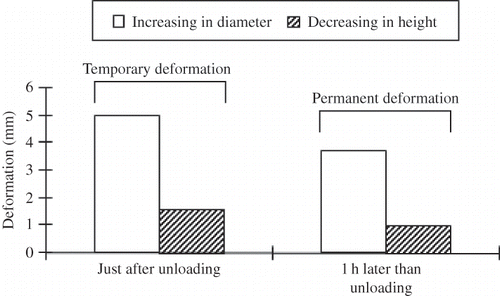
Both temporary deformation obtained just after unloading and permanent deformation obtained 1 h later from unloading in the height were found to be less, compared with deformation values in the diameter of the nectarines. While the deformation in diameter (measured from the stalk side of the nectarine) after loading ended was determined as 4.96 mm (standard deviation 0.31 mm), this value decreased to 3.7 mm (standard deviation 0.12 mm) after 1 h from uploading. While the deformation in height immediately after loading force ended was determined as 1.58 mm (standard deviation was 0.04 mm), this value decreased to 1 mm (standard deviation 0.021 mm) 1 h later from unloading.
shows the change in deformation versus force, applied from the cheek side and stalk side of nectarines (Bioyield points were labeled as “B”). As seen in these curves, almost similar forces created the same amount of deformations until occurring 4 mm deformation for stalk side and cheek side. After the 4-mm deformation, applied forces to the stalk side of the nectarine to create the same amount of deformation were found greater than forces applied to the cheek side. For example, an 11-mm deformation occurred at a force of 164 N, which was applied to the stalk side while the same deformation was obtained at a force of 120.2 N when force was applied from the cheek side. This means that the stalk side can withstand the application of a greater loading force compared with the cheek side loading to create the same level of deformation. Namely, the nectarine is more sensitive to initial cell rupture when it is subjected to force from the cheek side. The differences observed between the forces for obtaining equal deformations at the cheek side and stalk side of nectarines was found to be statistically significant (P < 0.01).
Figure 4 Force-deformation curves and bioyield points (B) of nectarines compressed from cheek side (deformation in height) and from stalk side (deformation in diameter). (Color figure available online.)
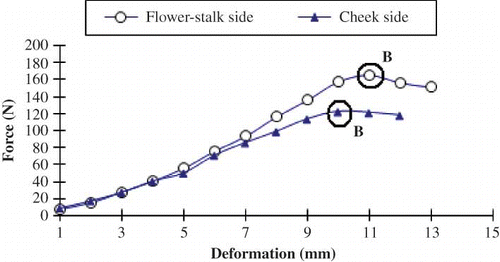
According to the compression tests results, it can be seen that the deformation in diameter was greater than the deformation observed in height. The deformation in height was calculated to be 31.9% of the deformation in diameter. One hour later from unloading, this value had fallen to 27%. Also, higher force application can cause the same amount of deformation when force was applied from the stalk side of nectarines compared with the force application from the cheek side of nectarines. It can be referred that nectarines are more sensitive to be deformed when exposed to forces from their cheek side. The differences observed in deformation suggest that the direction of possible mechanical forces must be taken into consideration during the packaging process.
Deformation energy values at the bioyield point related to loading positions are shown in Deformation energy recorded for compression from the stalk side of nectarines was found to be rather higher (1067 Nmm) than for compression of the cheek side of nectarines (607.5 Nmm). The differences of the mean deformation energy values determined for the two loading positions that are for cheek side and stalk side were statistically significant (P < 0.01).
Sitkei[Citation32] performed a research for peach fruit and determined that deformation for peach also occurred under a force of more than 15 N by performing static load tests. Poisson's ratio was established for 20 nectarine fruits that were subjected to a constant force by applying 20 N. The Poisson ratio values of nectarines varied between 0.25–0.42 (mean Poisson ratio for 20 nectarines = 0.33 ± 0.01). It can be said that similar to many other fruits, nectarine fruit is also not isotropic material, due to their changes observed in volume.[Citation27] Poisson ratio for different fruits and vegetables were determined by several researchers to be between 0.436–0.466 for cucumber,[Citation33] between 0.2–0.35 for apple,[Citation34] and 0.49 for potato.[Citation35]
Impact Tests
Absorbed energy, bruise volume, and bruise susceptibility values determined by dropping nectarine fruits from 30-, 40-, and 50-cm heights onto a metal surface are shown in Results of the variance analysis of impact test results for different drop heights and drop positions of the fruit were given in . According to the impact test results, the absorbed energy of the nectarines that were impacted from the bottom side was found to be lower than those impacted from the cheek side. The difference between absorbed energy values obtained from tests performed for different impact locations (bottom side and cheek side) was found to be statistically insignificant, while those data obtained from tests performed for different drop heights was found to be statistically significant at the 0.01 confidence level, as shown in . When the mean absorbed energy values of 20 nectarines were checked for each different drop direction and drop height, the maximum absorbed energy was found to be 215 Nmm for a fruit impacted on the cheek side from a 50-cm drop height; the minimum value was determined to be 108 Nmm for a fruit impacted on the bottom side from a 30-cm drop height (). Similar results were determined for tomato fruits by several researchers.[Citation15,Citation26] They informed that tomato partition, namely cross-wall tissue, absorbs more energy than a loculer tissue of a tomato, suggesting a higher bruise susceptibility of a tomato partition.
Figure 1 Changes in absorbed energy, bruise volume, and bruise susceptibility related to impact position and drop height of nectarines.
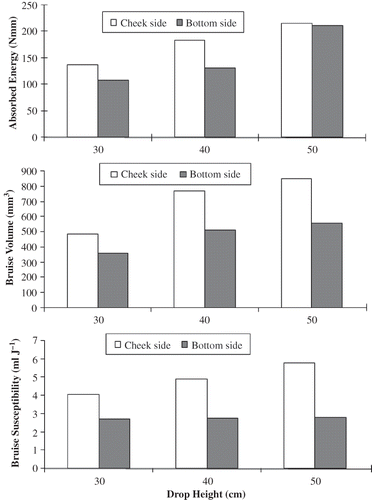
Table 1 Variance analysis results of impact tests at different drop heights and drop positions
Bruise volumes of nectarines after impact from either the cheek side or the bottom side tended to increase for every drop height (). Drop heights of 30, 40, and 50 cm were found as in three different groups with 0.01 importance level for bruise volume and absorbed energy values obtained for both cheek side and bottom side of nectarines according to Duncan test result. However, every test recorded a higher total bruise volume for impacts on the cheek side of the fruit. For example, minimum bruise volumes at the 30 cm drop height were found to be 361.15 mm3 for impact from the bottom side and 487.82 mm3 for impact from the cheek side; maximum bruise volumes at the 50-cm drop height were found to be 555.18 mm3 for impact from the bottom side and 848.23 mm3 for impact from the cheek side (). Crisosto et al.[Citation12] determined the effects of drop heights on the bruising damage for stone fruits. They found that increasing of drop heights increased the bruise size. They also found that 5-cm drop heights resulted in the size of the bruise for nectarine to be 31.3 mm2, while 15-cm drop heights resulted in the size of the bruise to be 79.4 mm2.
The difference between bruise volumes obtained for tests performed from different impact locations (bottom side and cheek side) was found to be statistically insignificant, while the differences observed in tests performed for different drop heights was found to be significant statistically at the 0.01 confidence level (). The same trend observed in bruise volume was also determined for bruise susceptibility of nectarines, namely, the susceptibility to bruising of the cheek side of the nectarine fruits was also inclined to increase with greater drop heights (). On the other hand, bruise susceptibility of nectarines when they were impacted from the bottom side were found to be almost similar for every drop height. Bruise susceptibility values of the bottom side of the nectarine for 30-, 40-, and 50-cm drop heights were calculated as 2.69, 2.72, and 2.78 ml J−1, respectively. In every test, higher total bruise susceptibility was found for tests carried out for the cheek side of the fruit, compared with those for the bottom side. For example, maximum bruise susceptibility values at the 50-cm drop height were found to be 5.75 ml J−1 for impact from the cheek side and 2.78 ml J−1 for impact from the bottom side, while minimum bruise susceptibility values at the 30-cm drop height were found to be 4.06 ml J−1 for impact from cheek side and 2.69 ml J−1 for impact from the bottom side (). The difference between bruise susceptibility values obtained from tests performed for different drop positions was found to be statistically significant at the 0.05 confidence level, while those obtained from tests performed for different drop heights were found to be statistically insignificant (as shown in ).
The results of this study demonstrated that the nectarines that were subjected to impact from the cheek side have a higher bruise volume and bruise susceptibility, while the nectarines are more resistant to impacts sustained from the bottom side. This indicates that a nectarine has different skin strength and tissue structure in its different parts. Identification of more sensitive points of nectarines to mechanical effects derived from this research resulted in a reduction of the percentage of damage especially in post harvest mechanization.
REFERENCES
- Salunkhe , D.K. and Desai , B.B. 1984 . Postharvest Biotechnology of Fruits , 168 Boca Raton , FL : CRC Press .
- Introduction , LaRue, J. 1989 . Peaches, Plums, and Nectarines: Growing and Handling for Fresh Market , Edited by: LaRue , J.H. and Johnson , R.S. 1 – 2 . Oakland, CA , , USA : University of California Division of Agriculture and Natural Resources (Publication 3331) .
- Lurie , A. and Crisosto , C.H. 2005 . Chilling injury in peach and nectarine . Postharvest Biology and Technology , 37 : 195 – 208 .
- Anonymous. Encyclopedia Britannica. http://www.britannica.com/EBchecked/topic/407794/nectarine (http://www.britannica.com/EBchecked/topic/407794/nectarine) (Accessed: 17 October 2009 ).
- Anonymous . 2004 . Fruit and Tree Nuts: Situation and Outlook Yearbook , TFS-271; United States Department of Agriculture, Economic Research Service, Washington, D.C. .
- Liverani , A. , Giovannini , D. and Brandi , F. 2002 . Increasing fruit quality of peaches and nectarines: The main goals of ISF-FO (Italy) . Acta Horticulturae , 592 : 507 – 514 .
- Hilaire , C. and Mathieu , V. 2004 . Le Point sur la Qualite Gustative des Peches et Nectarines [Focus on eating quality of peaches and nectarines.] In French. Infos-Ctifl . 201 : 27 – 31 .
- Bruhn , C.M. , Feldman , N. , Garlitz , C. , Harwood , J. , Ivans , E. , Marshall , M. , Riley , A. , Thurber , D. and Williamson , M. 1991 . Consumer perceptions of quality: Apricots, cantaloupes, peaches, pears, strawberries, and nectarines . Journal of Food Quality , 14 : 187 – 195 .
- Von Mollendorff , L.J. , Jacobs , G. and de Villiers , O.T. 1992 . Cold storage influences internal characteristics of nectarines during ripening . HortScience , 27 : 1295 – 1297 .
- Mitchell , F.G. 1987 . Influence of cooling and temperature maintenance on the quality of California grown stone fruit . International Journal of Refrigeration , 10 : 77 – 81 .
- Crisosto , C.H. , Mitchell , F.G. and Ju , Z. 1999 . Susceptibility to chilling injury of peach, nectarine, and plum cultivars grown in California . HortScience , 34 : 1116 – 1118 .
- Crisosto , C.H. , Slaughter , D. , Garner , D. and Boyd , J. 2001 . Stone fruit critical bruising thresholds . Journal American Pomological Society , 55 ( 2 ) : 76 – 81 .
- Blahovec , J. and Paprstein , F. 2005 . Susceptibility of pear varieties to bruising . Postharvest Biology and Technology , 38 : 231 – 238 .
- Crisosto , C.H. 1999 . Effect of preharvest factors and bruising in stone fruit decay . Perishables Handling Quarterly , 99 : 3 – 7 .
- Aktas , T. , Polat , R. and Atay , U. 2008 . Mechanical properties and bruise susceptibility of tomatoes related to impact direction and drop-height . The Philippine Agricultural Scientist , 91 ( 2 ) : 180 – 186 .
- Kampp , J. and Nissen , G. March 28–29 1990 . “ International Workshop on Impact Damage in Fruits and Vegetables ” . In Impact damage susceptibility of Danish apples March 28–29 , Valencia, Spain
- Blahovec , J. , Patocka , K. and Bares , J. 1997 . Low-level bruising of stored apples due to quasi-static loading up to constant compression strain . Journal of Texture Studies , 28 : 87 – 89 .
- Blahovec , J. , Patocka , K. and Paprstein , F. 1996 . Inelasticity and bruising of cherries . Journal of Texture Studies , 27 : 391 – 401 .
- Blahovec , J. , Vlckova , M. and Paprstein , F. 2002 . Static low-level bruising in pears . Research in Agricultural Engineering , 48 : 41 – 46 .
- Blahovec , J. 1999 . Bruise resistance coefficient and bruise sensitivity of apples and cherries . International Agrophysics , 13 : 315 – 321 .
- Mathew , R. and Hyde , G.M. 1997 . Potato impact damage thresholds . Transactions of the ASAE , 40 ( 3 ) : 705 – 709 .
- Grotte , M. , Duprat , F. , Pietri , E. and Loonis , D. 2002 . Young's modulus, Poisson's ratio, and Lame's coefficients of golden delicious apple . International Journal of Food Properties , 5 ( 2 ) : 333 – 349 .
- Grotte , M. , Duprat , F. and Loonis , D. 2001 . Mechanical properties of the skin and the flesh of apples . International Journal of Food Properties , 4 ( 1 ) : 149 – 161 .
- Wang , J. and Teng , B. 2006 . Firmness evaluation by drop impact characteristics for peach . International Journal of Food Properties , 9 ( 3 ) : 439 – 451 .
- Jarimopas , B. and Kitthawee , U. 2007 . Firmness properties of mangoes . International Journal of Food Properties , 10 : 899 – 909 .
- Van Zeebroeck , M. , Van Linden , V. , Darius , P. , De Ketelaere , B. , Ramon , H. and Tijkens , E. 2007 . The effect of fruit properties on the bruise susceptibility of tomatoes . Postharvest Biology and Technology , 45 ( 2 ) : 168 – 175 .
- Mohsenin , N.M. 1980 . Physical Properties of Plant and Animal Materials , 742 New York : Gordon and Breach Science Publishers .
- Aydin , C. and Carman , K. September 17–19in Turkish 1997 . “ Determination of bruising of peach related to impact energy ” . In Proceedings of the 17th National Congress on Mechanization in Agriculture September 17–19in Turkish , 773 – 778 . Tokat, Turkey
- Yurtlu , B. and Erdogan , D. 2005 . Effect of storage time on some mechanical properties and bruise susceptibility of pears and apples . Turkish Journal of Agriculture and Forestry , 29 : 469 – 482 .
- Alayunt , F. 2000 . Biological Material Knowledge , 132 Izmir , , Turkey : Ege University Agricultural Faculty . Publication No. 541;(in Turkish)
- Schoorl , D. and Holt , J.E. 1980 . Bruise resistance measurements in apples . Journal of Texture Studies , 11 : 389 – 394 .
- Sitkei , G. 1986 . Mechanics of Agricultural Materials , 487 Budapest , , Hungary : Akademial kiado .
- Yurtlu , Y.B. and Erdogan , D. 2005 . Effect of storage time on some mechanical properties of cucumber cultivars . Journal of Agricultural Sciences (Tarım Bilimleri Dergisi) , 11 ( 3 ) : 251 – 256 . in Turkish
- Mohsenin , N.N. 1986 . Physical Properties of Plant and Animal Materials , New York : Gordon and Breach Science Publishers .
- Burubai , W. , Amula , E. , Davies , R.M. , Etekpe , G.W.W. and Daworiye , S.P. 2008 . Determination of Poisson's ratio and elastic modulus of African nutmeg (Monodora myristica) . International Agrophysics , 22 : 99 – 102 .
